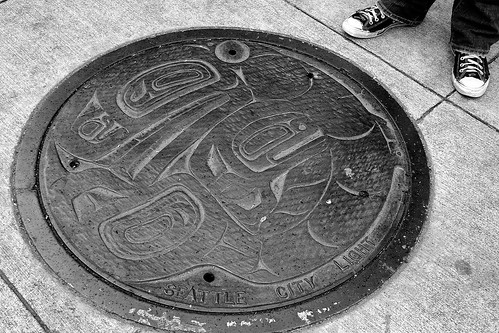
Photo & Text Copyright 2007 Seattle Daily Photo. All rights reserved, including reproduction or republishing.
You might remember the artistic City Light manhole cover photo I posted in August. I came upon this one near Pioneer Square and was really taken with it. This is one of 32 hatchcovers commissioned in 1976, carved in wood by Tlingit master carver Nathan Jackson, then cast. "Keet" is Tlingit for killer whale. "Nathan Jackson, Master Carver and a Chilkoot Tlingit, has been working in native arts since 1959. He attended the Institute of American Indian Arts in Santa Fe, New Mexico, where he specialized in fabric design, silkscreen, and graphics. Since 1967, he has been a freelance artist doing traditional style woodcarving, jewelry, and design. Jackson has completed numerous totem poles, screens, panels, and restoration projects. He has instructed woodcarving and design at several colleges, museums, and cultural centers." ~ info from Southeast Alaska Discovery Center Seattle+Seattle+Daily+Photo hatchcover manhole cover killer+whale keet Tlingit+art Tlingit+carving Native+carving Seattle+City+Light Seattle+public+art Nathan+Jackson master+carver orca
7 comments:
superbe, une vraie oeuvre d'art.
superb, a true work of art.
Don't know if it is you or blogger but I seem to be getting messages to say that a script on your site is not running properly -- something to do with Adobe Flash. Hope you can fix it.
Nice. My husband has Tlingit ancestry. His grandmother was Tlingit from Alaska. Thanks for the word for killer whale!
I knew it had something to do with Alaska - I've seen some textile and clothing designs and they looked similar. Great!
The traditons of Pacific Northwest native people's complex and bequtiful carving art is longstanding. Seattle has a history link to the Alaskan gold rush of the 1870s. A Seattle fellow in the curio trade in the late 1800s took Alaskan family totem poles and displayed them for the curious. There was a huge totem pole mounted in Pioneer Square, taken (I think) from the Alaskan village where Nathan Jackson now demonstrates Tlingit carving traditions. Somehow (probably because of his stature among all native carvers of the time) the Seattle public art folks back in the 70s chose him (rather than a local Seattle tribal artist) to create this work. The new totem pole errected in West Seattle at the lookout last year was carved by a local tribal member of the Duwamish. Carving traditions differ among all the people groups in the PWN that practice it, and each has it's own flavor. The Tlingit and Haida traditions, which to my uschooled eye seem similar, are probably the style you are recognizing as Alaskan. Really beautiful stuff. I recently viewed carvings at the BC Museum. It's a fascinating art.
-Kim
wow, that's a lot of work!
I like the B/W feature... and the point that you have this art as a street feature, that's great!
Hi! I've seen these all over, and am now even more surprised to know that "keet" means "whale" in Tlingit. In the Serbian language, the same word pronounced "keet" also means "whale". Now THAT'S interesting!
Post a Comment